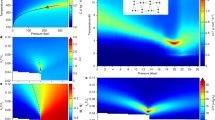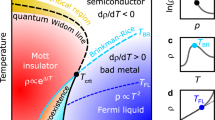Abstract
Changing the interactions between particles in an ensemble—by varying the temperature or pressure, for example—can lead to phase transitions whose critical behaviour depends on the collective nature of the many-body system. Despite the diversity of ingredients, which include atoms, molecules, electrons and their spins, the collective behaviour can be grouped into several families (called ‘universality classes’) represented by canonical spin models1. One kind of transition, the Mott transition2, occurs when the repulsive Coulomb interaction between electrons is increased, causing wave-like electrons to behave as particles. In two dimensions, the attractive behaviour responsible for the superconductivity in high-transition temperature copper oxide3,4 and organic5,6,7 compounds appears near the Mott transition, but the universality class to which two-dimensional, repulsive electronic systems belongs remains unknown. Here we present an observation of the critical phenomena at the pressure-induced Mott transition in a quasi-two-dimensional organic conductor using conductance measurements as a probe. We find that the Mott transition in two dimensions is not consistent with known universality classes, as the observed collective behaviour has previously not been seen. This peculiarity must be involved in any emergent behaviour near the Mott transition in two dimensions.
This is a preview of subscription content, access via your institution
Access options
Subscribe to this journal
Receive 51 print issues and online access
$199.00 per year
only $3.90 per issue
Buy this article
- Purchase on Springer Link
- Instant access to full article PDF
Prices may be subject to local taxes which are calculated during checkout




Similar content being viewed by others
References
Kadanoff, L. P. et al. Static phenomena near critical points: Theory and experiment. Rev. Mod. Phys. 39, 395–431 (1967)
Mott, N. F. Metal-Insulator Transitions (Taylor & Francis, London, 1990)
Imada, M., Fujimori, A. & Tokura, Y. Metal-insulator transitions. Rev. Mod. Phys. 70, 1039–1263 (1998)
Damascelli, A., Hussain, Z. & Shen, Z.-X. Angle-resolved photoemission studies of the cuprate superconductors. Rev. Mod. Phys. 75, 473–541 (2003)
Mayaffre, H., Wzietek, P., Jérome, D., Lenoir, C. & Batail, P. Superconducting state of κ-(ET)2CU[N(CN)2]Br studied by 13C NMR: Evidence for vortex-core-induced nuclear relaxation and unconventional pairing. Phys. Rev. Lett. 75, 4122–4125 (1995)
De Soto, S. M. et al. 13C NMR studies of the normal and superconducting states of the organic superconductor κ-(ET)2Cu[N(CN)2]Br. Phys. Rev. B 52, 10364–10368 (1995)
Kanoda, K., Miyagawa, K., Kawamoto, A. & Nakazawa, Y. NMR relaxation rate in the superconducting state of the organic conductor κ-(BEDT-TTF)2Cu[N(CN)2]Br. Phys. Rev. B 54, 76–79 (1996)
Limelette, P. et al. Universality and critical behavior at the Mott transition. Science 302, 89–92 (2003)
Kino, H. & Fukuyama, H. Phase diagram of two-dimensional organic conductors: (BEDT-TTF) 2X. J. Phys. Soc. Jpn 65, 2158–2169 (1996)
Mckenzie, R. H. Similarities between organic and cuprate superconductors. Science 278, 820–821 (1997)
Kanoda, K. Electron correlation, metal-insulator transition and superconductivity in quasi-2D organic systems, (ET)2X. Physica C 282, 299–302 (1997)
Miyagawa, K., Kawamoto, A. & Kanoda, K. Proximity of pseudogapped superconductor and commensurate antiferromagnet in a quasi-two-dimensional organic system. Phys. Rev. Lett. 89, 017003 (2002)
Lefebvre, S. et al. Mott transition, antiferromagnetism, and unconventional superconductivity in layered organic superconductors. Phys. Rev. Lett. 85, 5420–5423 (2000)
Fournier, D., Poirier, M., Castonguay, M. & Truong, K. Mott transition, compressibility divergence, and the P-T phase diagram of layered organic superconductors: An ultrasonic investigation. Phys. Rev. Lett. 90, 127002 (2003)
Limelette, P. et al. Mott transition and transport crossovers in the organic compound κ-(BEDT-TTF)2Cu[N(CN)2]Cl. Phys. Rev. Lett. 91, 016401 (2003)
Kagawa, F., Itou, T., Miyagawa, K. & Kanoda, K. Transport criticality of the first-order Mott transition in the quasi-two-dimensional organic conductor κ-(BEDT-TTF)2Cu[N(CN)2]Cl. Phys. Rev. B 69, 064511 (2004)
Williams, J. M. et al. From semiconductor-semiconductor transition (42 K) to the highest-TC organic superconductor, κ-(ET)2Cu[N(CN)2]Cl (TC = 12.5 K). Inorg. Chem. 29, 3272–3274 (1990)
Georges, A. Strongly correlated electron materials: Dynamical mean-field theory and electronic structure. AIP Conf. Proc. 715, 3–74 (2004)
Castellani, C., DiCastro, C., Feinberg, D. & Ranninger, J. New model Hamiltonian for the metal-insulator transition. Phys. Rev. Lett. 43, 1957–1960 (1979)
Kotliar, G., Lange, E. & Rozenberg, M. J. Landau theory of the finite temperature Mott transition. Phys. Rev. Lett. 84, 5180–5183 (2000)
Imada, M. Quantum Mott transition and multi-furcating criticality. J. Phys. Soc. Jpn 73, 1851–1863 (2004)
Imada, M. Quantum Mott transition and superconductivity. J. Phys. Soc. Jpn 74, 859–862 (2005)
Georges, A., Kotliar, G., Krauth, W. & Rozenberg, M. J. Dynamical mean-field theory of strongly correlated fermion systems and the limit of infinite dimensions. Rev. Mod. Phys. 68, 13–125 (1996)
Kotliar, G. & Vollhardt, D. Strongly correlated materials: Insights from dynamical mean-field theory. Phys. Today 57(3), 53–59 (2004)
Onoda, S. Ginzburg-Landau theory and classical critical phenomena of Mott transition. Preprint at http://xxx.lanl.gov/abs/cond-mat/0408207 2004.
Acknowledgements
We thank M. Imada, T. Itou, S. Miyashita, N. Nagaosa, S. Onoda, Y. Shimizu and N. Todoroki for discussions.
Author information
Authors and Affiliations
Corresponding author
Ethics declarations
Competing interests
Reprints and permissions information is available at npg.nature.com/reprintsandpermissions. The authors declare no competing financial interests.
Supplementary information
Supplementary Figure S1
This figure shows the pressure dependence of conductance at the critical temperature. It also gives the critical conductance and the critical pressure needed to determine the critical exponents. (PDF 121 kb)
Supplementary Table S1
This table lists universality classes and the representative phase transitions belonging to them. (DOC 32 kb)
Supplementary Discussion
This provides the theoretical proof and the experimental demonstration for the validity of the present data analysis. This also includes Supplementary Figures S2 and S3. (PDF 842 kb)
Rights and permissions
About this article
Cite this article
Kagawa, F., Miyagawa, K. & Kanoda, K. Unconventional critical behaviour in a quasi-two-dimensional organic conductor. Nature 436, 534–537 (2005). https://doi.org/10.1038/nature03806
Received:
Accepted:
Issue Date:
DOI: https://doi.org/10.1038/nature03806
This article is cited by
-
Thermoelectric signature of quantum critical phase in a doped spin-liquid candidate
Nature Communications (2023)
-
Pressure-induced transition from a Mott insulator to a ferromagnetic Weyl metal in La2O3Fe2Se2
Nature Communications (2023)
-
Moiré heterostructures as a condensed-matter quantum simulator
Nature Physics (2021)
-
A quantum magnetic analogue to the critical point of water
Nature (2021)
-
Petahertz non-linear current in a centrosymmetric organic superconductor
Nature Communications (2020)
Comments
By submitting a comment you agree to abide by our Terms and Community Guidelines. If you find something abusive or that does not comply with our terms or guidelines please flag it as inappropriate.



